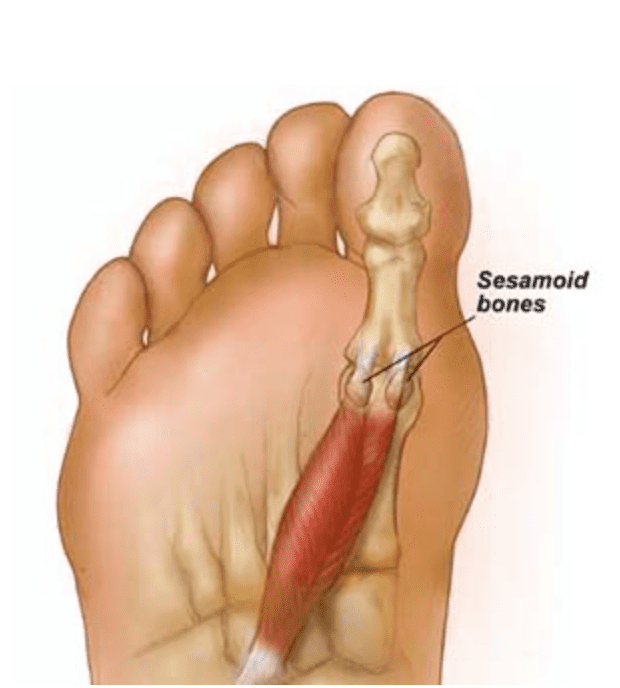
Jump to section
Sesamoiditis is the most common cause of pain beneath the big toe that our podiatrists see in runners and those that are physically active, across our Brisbane City and Newmarket clinics.
 Sesamoiditis
is an overload injury that causes pain, swelling and discomfort at and beneath the big toe joint. The
term ‘sesamoiditis’ comes from the name of bones affected in this injury - the sesamoid bones, paired with ‘itis’
which means inflammation. Hence, the term literally translates to inflamed sesamoid bones.
Sesamoiditis
is an overload injury that causes pain, swelling and discomfort at and beneath the big toe joint. The
term ‘sesamoiditis’ comes from the name of bones affected in this injury - the sesamoid bones, paired with ‘itis’
which means inflammation. Hence, the term literally translates to inflamed sesamoid bones.
Your sesamoids are two small pea-shaped and sized bones that sit right below your big toe joint at the ball of the foot. They are not directly connected to the big toe joint in the same way all of the other bones are connected via regular joint, but instead they are embedded within a tendon that runs directly beneath your big toe called the flexor hallucis brevis. Here, they support the function of the tendon as you walk and run. Thus, moving this tendon while you have sesamoiditis will produce painful symptoms.
Sesamoiditis is one of the leading causes of pain beneath the big toe joint at the ball of the foot during physical activity. You may also notice some swelling or redness around the joint, and bending your toe upwards will likely feel tender. Often, sesamoid pain starts as a mild ache and gradually worsens, although it can come on suddenly too, especially if you haven’t noticed the discomfort building up. You’ll typically feel better when resting, and physical activity or loading the ball of your foot will exacerbate your pain.
Being an overuse injury, the big toe joint at the ball of the foot, and hence the sesamoids, are repetitively loaded past the point that it can handle until damage occurs. While we often see sesamoiditis in dancers and runners due to the significant time spent on the forefoot in these sports, the overloading can come from a range of factors, including:
The people we see in our clinic with sesamoiditis often tend to be those that are active in sports, as well as those that wear high heels throughout the day at work. Occasionally we also see sesamoiditis in those with arthritis that affects their forefoot, namely rheumatoid arthritis or gout.
Sesamoiditis can be confidently diagnosed by our podiatrists during your biomechanical assessment with us. Sesamoiditis has key distinguishing features that we look for that can separate it from other causes of pain at the ball of the foot like capsulitis, bursitis, plantar plate tears and more. If we’re concerned about a fracture to your sesamoid bone, are concerned about multiple conditions affecting the ball of your foot at once, or need to investigate further, we may refer you for ultrasound or x-ray imaging.
After we confirm your sesamoid injury and get an understanding of why it has occurred from your extensive biomechanical assessment paired with getting to know your habits and lifestyle, our podiatrists will prescribe a custom treatment plan for you. As with any forefoot pain, there are three stages to treating sesamoiditis: relieving your initial symptoms, supporting the damaged structures to heal and make a full recovery, and finally keeping you pain-free by putting the right measures in place to help reduce the risk of the problem returning in the future.
We follow evidence-based guidelines for treatment to help you get the best results for your foot pain, and pair this with the range of innovative solutions we have uniquely available at our clinic. Your treatment plan may involve a combination of:
The best way to help prevent sesamoiditis is to follow good care principles for your feet and legs: wear good supportive shoes and replace sports shoes regularly, avoid high heels, complete stretching and strengthening exercises for your feet, and don’t ignore small pains and niggles in your feet - get them sorted before they turn into a full blown injury.
Mild cases of sesamoiditis may heal on their own if the causative factors are addressed - the big toe is no longer overloaded and the area has a chance to heal. We often see people who have put up with their pain for weeks with no relief, and so need help to rehabilitate the injury.
Immediately beneath the big toe joint at the ball of the foot.
Once you start treatment, it can take between 2-8 weeks in our experience to get to a completely pain-free state. With this said, we expect significant improvements in your pain and comfort during regular walking from your first appointment where we apply some off-loading padding, and then even more so once you get your custom foot orthotics.
| Monday | 7:40am - 6:00pm |
| Tuesday | 7:40am - 6:00pm |
| Wednesday | 7:40am - 6:00pm |
| Thursday |
7:40am - 6:00pm |
| Friday | TEMP CLOSED |
| Saturday | CLOSED |
| Sunday | CLOSED |
Ground Floor, 344 Queen Street,
Brisbane City QLD 4000
| Monday | 7:40am - 6:00pm |
| Tuesday | 7:40am - 6:00pm |
| Wednesday | 7:40am - 6:00pm |
| Thursday |
7:40am - 6:30pm |
| Friday | 7:40am - 5:00pm |
| Saturday | 7:40am - 4:30pm |
| Sunday | CLOSED |
Newmarket Village, 114/400 Newmarket Rd, Newmarket QLD 4051